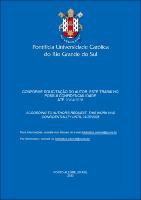| Share record |


|
Please use this identifier to cite or link to this item:
https://tede2.pucrs.br/tede2/handle/tede/10720| Document type: | Dissertação |
| Title: | Envelhecimento acelerado no transtorno por uso de cocaína : uma análise de espessura cortical cerebral |
| Author: | Rothmann, Leonardo Melo  |
| Advisor: | Oliveira, Rodrigo Grassi |
| Abstract (native): | Embora os Transtornos por Uso de Substâncias tenham sido associados ao envelhecimento acelerado, apenas alguns estudos de neuroimagem investigaram essa hipótese até agora. Neste estudo transversal, realizamos um exame de ressonância magnética estrutural cerebral para medir a Espessura Cortical (CT) em adultos trigenários com Transtorno por Uso de Cocaína (CUD, n1 = 30) e seus controles pareados por idade (YC, n1 = 30), e compará-los com idosos octogenários controles (EC, n1 = 20). Descobrimos que a CT no giro fusiforme direito foi semelhante entre os grupos CUD e EC, além de serem mais finos do que os valores encontrado no grupo YC. Também descobrimos que, em relação à CT do giro temporal inferior direito e do córtex parietal direito, o grupo CUD exibiu parâmetros que caíram entre os grupos EC e YC. Finalmente, a CT do giro temporal inferior esquerdo, giro temporal superior direito, pars triangularis em fronteira com o giro orbitofrontal direito e giro pré-central direito mostraramse reduzidas no grupo CUD quando comparadas com o grupo YC. Entretanto, essas áreas não estavam relacionadas a CT do grupo EC. Apesar da diferença de idade de 50 anos entre nossas faixas etárias, a CT de usuários trigenários de cocaína reúne características de um cérebro octogenário, reforçando a hipótese de envelhecimento acelerado no CUD. |
| Abstract (english): | It has been suggested that Substance Use Disorders could lead to accelerated biological aging, but only a few neuroimaging studies have investigated this hypothesis so far. In this crosssectional study, structural neuroimaging was performed to measure Cortical Thickness (CT) in tricenarian adults with Cocaine Use Disorder (CUD, n1 = 30) and their age-paired controls (YC, n1 = 30), and compare it with octogenarian elder controls (EC, n1 = 20). We found that CT in the right fusiform gyrus was similar between CUD and EC, thinner than the expected values of YC. We also found that regarding CT of the right Inferior Temporal gyrus and right Parietal cortex, the CUD group exhibited parameters that fell in between EC and YC groups. Finally, CT of the left Inferior Temporal gyrus, right Superior Temporal gyrus, right Precentral gyrus, and right pars triangularis bordering with orbitofrontal gyrus were reduced in CUD when contrasted with YC, but those areas were unrelated to CT of EC. Despite the 50 years age gap between our age groups, CT of tricenarian cocaine users assembles features of an octogenarian brain, reinforcing the accelerated aging hypothesis in CUD. |
| Keywords: | Cocaína Envelhecimento Neuroimagem Estrutural Afinamento Cortical Lobo Temporal Lobo Frontal Cocaine Aging Structural Neuroimaging Cortical Thinning Temporal Lobe Frontal Lobe |
| CNPQ Knowledge Areas: | CIENCIAS DA SAUDE::MEDICINA |
| Language: | por |
| Country: | Brasil |
| Publisher: | Pontifícia Universidade Católica do Rio Grande do Sul |
| Institution Acronym: | PUCRS |
| Department: | Escola de Medicina |
| Program: | Programa de Pós-Graduação em Medicina e Ciências da Saúde |
| Access type: | Acesso Aberto |
| Fulltext access restriction: | Trabalho será publicado como artigo ou livro |
| Time to release fulltext: | 60 meses |
| Date to release fulltext: | 20/04/2028 |
| URI: | https://tede2.pucrs.br/tede2/handle/tede/10720 |
| Issue Date: | 28-Mar-2023 |
| Appears in Collections: | Programa de Pós-Graduação em Medicina e Ciências da Saúde |
Files in This Item:
| File | Description | Size | Format | |
|---|---|---|---|---|
| DIS_LEONARDO_MELO_ROTHMANN_CONFIDENCIAL.pdf | LEONARDO_MELO_ROTHMANN_DIS | 302.09 kB | Adobe PDF |  Download/Open Preview |
Items in DSpace are protected by copyright, with all rights reserved, unless otherwise indicated.




